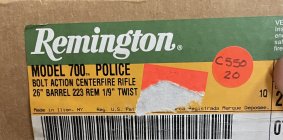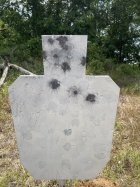I looked for the comment about the plastic tip having little effect and it sounded to me that because the plastic tip lengthens the bullet it must be accounted for in the overall length of the bullet. I experience really good results using the 73 ELD Match in a 1:9 twist Remington 700P .223. I shoot 3 inch or better groups at 600 yards with Starline brass 25.0 gr CFE223. I modified the freebore and lead angle with a Reamer from 4D reamer rental. My best groups are 0.070 off the lands. I’m wondering if I’m being able to do this because the Calculator says I’m WAY below stability.
You are using an out of date browser. It may not display this or other websites correctly.
You should upgrade or use an alternative browser.
You should upgrade or use an alternative browser.
Hornady ELD Match bullets and the Twist Rate Calculator.
- Thread starter William Vogel
- Start date
jelenko
Gold $$ Contributor
What altitude are you shoot at?I looked for the comment about the plastic tip having little effect and it sounded to me that because the plastic tip lengthens the bullet it must be accounted for in the overall length of the bullet. I experience really good results using the 73 ELD Match in a 1:9 twist Remington 700P .223. I shoot 3 inch or better groups at 600 yards with Starline brass 25.0 gr CFE223. I modified the freebore and lead angle with a Reamer from 4D reamer rental. My best groups are 0.070 off the lands. I’m wondering if I’m being able to do this because the Calculator says I’m WAY below stability.
About 360 feet above sea level. I’m in southwest Georgia.What altitude are you shoot at?
That’s exactly what I shoot them. 25.0 grains of CFE223. 2800fps.Hmm - the JBM stability calculator says at 2800 fps [is that close to your muzzle velocity?], 9 twist and 360 ft above sea level, a 73 eld is completely stable.
His actual measurements for that bullet are not too different than the Berger Twist Rate Calculator and JBM Stability Calculator [without the plastic tip input] outputs,
Ned, I'm sure Bryan and the AB team have simply used a Miller-type stability solver for the Sg / twist rate calculations shown in Ballistic Performance of Rifle Bullets 3rd edition that you copy in your post.
I won't (daren't!) comment on the accuracy of the book's twist rates for plastic tipped bullets, but the values given for flat-based bullets are simply incorrect, as Berger's own stability calculator website page makes clear. Quote:
"Important Note: The Miller Twist Rate Formula isn’t accurate with flat based bullets, so we recommend you view our flat based bullet twist rate chart to identify what the minimum twist rate is for all of our flat based bullets."
To take an example, the FB bullets' listings gives 1:10 as the required twist for the 6mm 88gn High BC FB Varmint whilst the book shows this twist rate to give an Sg of only 1.25 in the nominal category.
(Miller formula type calculators are designed for boat-tail bullets and FBs need slower rotation speeds to achieve optimum stability levels equivalent to one to two turns per inch in rifling pitch terms.)
While I won’t doubt any of these conclusions from anyone here, I shot the Remington 700P yesterday at 700 yards with these bullets. I didn’t chronograph them but simply called them 2800 fps in my ballistic calculator. They actually shot about 1 moa high but I maintained my hold and landed 10 for 10 in varying wind and quite a mirage. I shot from a Caldwell front bag and a sock filled with airsoft beads in the rear that I squeeze to obtain 0. The head of the target steel is a 6 inch square. I’ve shot much better with this rifle in better conditions but I think it’s acceptable for the fact that it’s a factory barrel with only a throat modification.
Attachments
Coyotefurharvester
Silver $$ Contributor
Have you actually measured/checked the barrels twist rate. Remington has surprised me with twists that are "off" a bit.
No I haven’t and this is a really good idea. Maybe I should have thought of it. I’ll check it.Have you actually measured/checked the barrels twist rate. Remington has surprised me with twists that are "off" a bit.
jelenko
Gold $$ Contributor
JBM shows a stability factor of 1.5 [at 360 ft above sea level]Using the Berger Twist Rate Calculator, I would not say that it predicts the 73 gr ELDM to be completely stable at an elevation of 360 ft and 70 degrees F. The following inputs were used:
View attachment 1438398
The following output was returned:
View attachment 1438399
An Sg of 1.19 is very marginal. For example, a few degrees colder and you might be looking at a situation where the bullet will begin putting oblong holes in the target, although probably not outright keyholing. Regardless, an Sg of 1.19 means giving up a substantial amount of the innate BC. It is important to note that the Berger twist rate calculator does not offer any input for a plastic tip.
Using the same bullet dimensions and weight at JBM Ballistics, and including a plastic tip length input of 0.150" yields the following [very different] output:
View attachment 1438401
However, if one removes the 0.150" plastic tip length, then the JBM output is pretty close to the Berger output:
View attachment 1438407
To be clear, I think the outputs are the same (i.e. Sg) for the two different twist rate calculators, but am not 100% certain. JBM refers to their output as the Miller Stability Value. The point here is that not all twist rate stability calculators yield the same results, even given the same basic inputs. Finally, although the outputs differ substantially if the plastic tip data is included/accounted for in the calculator, Bryan Litz has done actual stability and BC determinations for the Hornady 73 gr ELDM using radar data. His actual measurements for that bullet are not too different than the Berger Twist Rate Calculator and JBM Stability Calculator [without the plastic tip input] outputs, the difference being that the actual measurements suggested ever so slightly more favorable stability (see "Nominal" and "Worst Case" outputs in the table at the bottom).
View attachment 1438414
Attachments
Well I just checked my barrel 5 times with different nylon brushes and a bore mop and I get right at 1:8 every time. It’s funny though because the box says 1:9 and every publication says 1:9 for this rifle. The barrel stamp date code is LX. I just got it about 6 months ago but it’s an old rifle but new in box.


I rechecked my twister again this morning with a Boretech 30 inch rod and with 2 revolutions I’m getting 18 inches. Yesterday I was using a multi piece old rod and hand feeding it. Must have been manipulating it. This morning I’m drawing it from the chamber end towards the muzzle and using a tape flag after a few inches of rifling engagement with a tighter brush. It really only makes sense that it’s a 9 twist. I don’t think Remington would fudge up the machining process with 22cal barrels. Back in 2003 I’m not aware of them offering 8 twists for anything.
I shoot .22 PPC with 7.5 twist, two 5r Bartlein barreled rifles at 600 yards from a bench. I like the 73 ELD-M in these rifles. The 73gr Berger is more accurate in my 8 twist .22 BR than these Hornady bullets. I shot 7 shots on the Bench Rest champion's shot marker with the above .22 BR rifle a couple of seasons ago. The group was under an inch.
Similar threads
- Replies
- 20
- Views
- 7,287
Upgrades & Donations
This Forum's expenses are primarily paid by member contributions. You can upgrade your Forum membership in seconds. Gold and Silver members get unlimited FREE classifieds for one year. Gold members can upload custom avatars.

Click Upgrade Membership Button ABOVE to get Gold or Silver Status.
You can also donate any amount, large or small, with the button below. Include your Forum Name in the PayPal Notes field.
To DONATE by CHECK, or make a recurring donation, CLICK HERE to learn how.

Click Upgrade Membership Button ABOVE to get Gold or Silver Status.
You can also donate any amount, large or small, with the button below. Include your Forum Name in the PayPal Notes field.
To DONATE by CHECK, or make a recurring donation, CLICK HERE to learn how.











